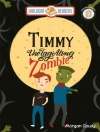‘This book is a crucial tool for meeting NCTM mathematical content and process standards. Through the useful problems and strategies presented within, teachers will definitely know how well their students will comprehend. If comprehension is an issue in your class, this book is a must have!’
—Therese Gessler Rodammer, Math Coach
Thomas W. Dixon Elementary School, Staunton, VA
Seeing is believing with this interactive approach to math instruction
Do you ever wish your students could read each other′s thoughts? Now they can—and so can you! Veteran mathematics educators Ted Hull, Don Balka, and Ruth Harbin Miles explain why making students′ thought processes visible is the key to effective mathematics instruction. Their newest book contains numerous grade-specific sample problems and instructional strategies for teaching essential concepts such as number sense, fractions, and estimation. Among the many benefits of visible thinking are:
- Interactive student-to-student learning
- Increased class participation
- Development of metacognitive thinking and problem-solving skills
Helpful features include vignettes, relevant word problems, classroom scenarios, sample problems, lesson adaptations, and easy-to-follow examples of each strategy in action. The authors also explain how students can demonstrate their thinking using calculators and online tools. The final chapter outlines steps math leaders can take to implement visible thinking and maximize mathematics comprehension for all students.
Tabla de materias
Preface
Acknowledgments
About the Authors
Part I. Preparing the Foundation
1. What Is Visible Thinking?
Understanding Mathematical Concepts
Thinking as a Mathematical Premise
Visible Thinking in Classrooms
Visible Thinking Scenario 1: Area and Perimeter
Summary
2. How Do Students Learn Mathematics?
What Is Thinking?
What Does Brain Research Indicate About Thinking and Learning?
What Is Mathematical Learning?
What Are Thinking and Learning Themes From Research?
Example Problems Revisited
Visible Thinking Scenario 2: Addition of Fractions
Summary
3. What Is Happening to Thinking in Mathematics Classrooms?
Improvement Initiatives and Visible Thinking
Visible Thinking Scenario 3: Subtraction With Regrouping
Summary
Part II. Promoting Visible Thinking With an Alternative Instructional Model
4. How Do Effective Classrooms Depend on Visible Thinking?
What Are Strategies, Conditions, and Actions?
Practice Into Action
Technology as Visible Thinking
Visible Thinking Scenario 4: Division
Summary
5. How Are Long-Term Changes Made?
Enhancing Student Learning
Teaching Approaches
Visible Thinking Scenario 5: Mixed Numerals
Visible Thinking Scenario 6: Place Value
Summary
6. How Are Short-Term Changes Made?
Pitfalls and Traps
Strategy Sequence
The Relationships Among the Strategy Sequence, Conditions, and Goals
Visible Thinking Scenario 7: Basic Addition and Subtraction Facts
Visible Thinking Scenario 8: Exponents
Summary
7. How Are Lessons Designed to Achieve Short-Term and Long-Term Changes?
The Current Approach to Teaching Mathematics
Elements of an Alternative Instructional Model
Types of Problems
Summary
Part III. Implementing the Alternative Model at Different Grade Levels
8. How Is Thinking Made Visible in Grades K–2 Mathematics?
Brainteaser Problem Example
Group-Worthy Problem Example
Transforming Problem Example
Summary
9. How Is Thinking Made Visible in Grades 3–5 Mathematics?
Brainteaser Problem Example
Group-Worthy Problem Example
Transforming Problem Example
Summary
10. How Is Thinking Made Visible in Grades 6–8 Mathematics?
Brainteaser Problem Example
Group-Worthy Problem Example
Transforming Problem Example
Summary
Part IV. Continuing the Work
11. How Do Teachers, Leaders, and Administrators Coordinate Their Efforts to Improve Mathematics Teaching and Learning?
Working With Administrators
Embedding Lessons Into the Curriculum
Providing Professional Development
Co-planning and Co-teaching
Summary
Appendix A: Research Support for Visible Thinking Strategies, Conditions, and Actions
Appendix B: Lessons Using Technology: Additional Materials
References
Index
Sobre el autor
Ruth Harbin Miles coaches rural, suburban, and inner-city school mathematics teachers. Her professional experiences include coordinating the K-12 Mathematics Teaching and Learning Program for the Olathe, Kansas, Public Schools for more than 25 years; teaching mathematics methods courses at Virginia’s Mary Baldwin College; and serving on the Board of Directors for the National Council of Teachers of Mathematics, the National Council of Supervisors of Mathematic, and both the Virginia Council of Teachers of Mathematics and the Kansas Association of Teachers of Mathematics. Ruth is a co-author of five Corwin books including A Guide to Mathematics Coaching, A Guide to Mathematics Leadership, Visible Thinking in the K-8 Mathematics Classroom, The Common Core Mathematics Standards, and Realizing Rigor in the Mathematics Classroom. As co-owner of Happy Mountain Learning, Ruth specializes in developing teachers’ content knowledge and strategies for engaging students to achieve high standards in mathematics.












